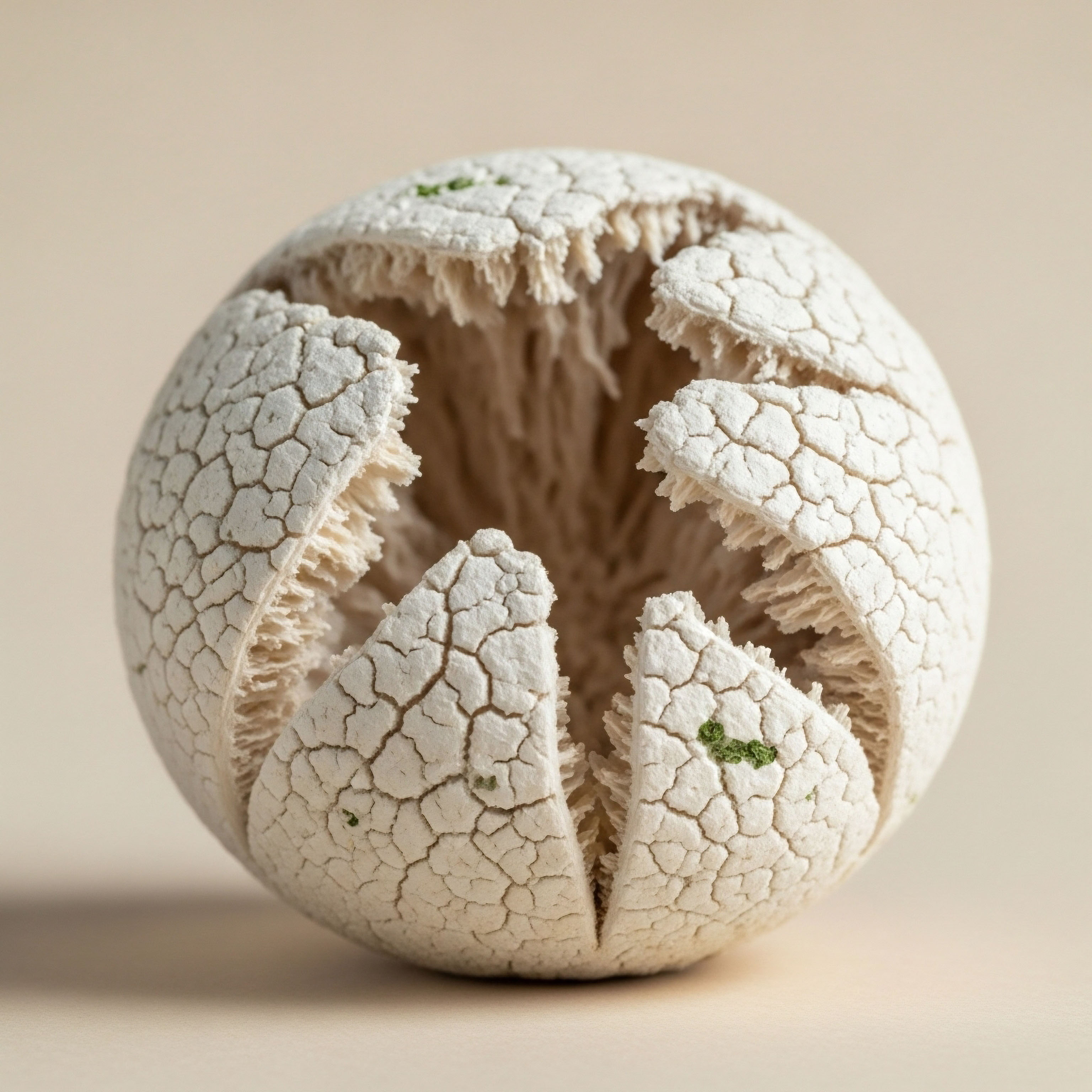

Fundamentals
You may be here because you’ve noticed a subtle shift in your body’s rhythm. Perhaps the energy that once propelled you through your days now feels less accessible. You might be seeking to understand the intricate systems that govern your vitality, looking for ways to support your body’s functions as you navigate different life stages.
This exploration into Growth Hormone Releasing Peptides (GHRPs) and their relationship with your cardiovascular system is a part of that journey. It is a process of learning your body’s unique language to better support its long-term health.
Your body operates as a finely tuned orchestra, with the endocrine system acting as the conductor. This system uses chemical messengers called hormones to communicate between different organs and tissues, regulating everything from your metabolism and mood to your sleep cycles and growth. Each hormone has a specific role, and their balanced interplay is essential for your overall well-being. When this delicate balance is disrupted, you may begin to experience symptoms that can affect your quality of life.

The Role of Growth Hormone
One of the principal conductors in this orchestra is Growth Hormone (GH), a protein produced by the pituitary gland, a small pea-sized gland at the base of your brain. During childhood and adolescence, GH plays a critical role in growth and development.
In adulthood, its responsibilities shift to maintaining the health and integrity of your tissues and organs. It influences muscle mass, bone density, and metabolic function, including how your body processes fats and sugars. The production of GH naturally declines with age, a change that can contribute to some of the physical shifts experienced over time.
Understanding the fundamental role of growth hormone in adult physiology is the first step toward comprehending the implications of therapies designed to influence its production.
This decline in GH has led to interest in therapies that can support the body’s natural production of this vital hormone. One such approach involves the use of Growth Hormone Releasing Peptides, or GHRPs. These are specialized molecules that signal the pituitary gland to release its own stores of GH. This method is distinct from administering synthetic GH directly, as it works with your body’s inherent biological pathways.

Introducing Growth Hormone Releasing Peptides
GHRPs are a class of peptides that act as secretagogues, which means they are substances that cause another substance to be secreted. In this case, they stimulate the pituitary gland to secrete GH. Some common examples of GHRPs used in clinical settings include:
- Sermorelin ∞ A peptide that mimics the action of Growth Hormone Releasing Hormone (GHRH), the body’s natural signal for GH release.
- Ipamorelin ∞ A more selective GHRP that stimulates GH release with minimal impact on other hormones like cortisol.
- CJC-1295 ∞ A long-acting peptide that is often combined with Ipamorelin to provide a sustained increase in GH levels.
These peptides are often considered for their potential to improve body composition, enhance recovery, and support overall vitality. Their mechanism of action, which relies on the body’s own regulatory systems, is a key aspect of their clinical profile.

Your Cardiovascular System a Foundation of Health
Your cardiovascular system is the intricate network responsible for transporting oxygen, nutrients, and hormones throughout your body. It comprises your heart, a powerful muscular pump, and a vast network of blood vessels, including arteries, veins, and capillaries. The health of this system is foundational to your overall well-being. The efficiency of your heart as a pump and the flexibility of your blood vessels directly impact your energy levels, cognitive function, and physical performance.
The connection between the endocrine system and the cardiovascular system is profound. Hormones can influence heart rate, blood pressure, and the way your blood vessels function. Given the systemic role of GH, it is logical to consider how influencing its levels through GHRPs might have implications for cardiovascular health. The following sections will explore this relationship in greater detail, moving from foundational concepts to a more nuanced clinical understanding.


Intermediate
As we move beyond the foundational concepts, we can begin to examine the specific ways in which sustained use of GHRPs may interact with the cardiovascular system. This requires a more detailed look at the mechanisms of action of these peptides and the clinical observations associated with their use. The conversation shifts from what GHRPs are to what they do within the complex environment of the human body.
The use of GHRPs in a clinical setting is predicated on the idea of restoring a more youthful hormonal environment. The goal is to leverage the body’s own machinery to optimize function. This approach has both potential benefits and considerations that warrant a careful and informed perspective, particularly concerning cardiovascular health.

A Closer Look at Common GHRPs
Different GHRPs have distinct properties that influence their clinical application. Understanding these differences is important for appreciating their potential cardiovascular implications. The table below provides a comparison of three commonly used GHRPs.
| Peptide | Mechanism of Action | Primary Characteristics |
|---|---|---|
| Sermorelin | Acts on the GHRH receptor, mimicking the body’s natural signal for GH release. | Short-acting, promotes a natural pulsatile release of GH. |
| Ipamorelin | Acts on the ghrelin receptor (GHS-R) to stimulate GH release. | Highly selective for GH release with minimal effect on cortisol or prolactin. |
| CJC-1295 | A long-acting GHRH analogue that extends the half-life of GHRH. | Provides a sustained elevation of GH and IGF-1 levels. Often used in combination with Ipamorelin. |

Potential Cardiovascular Benefits of GHRP Use
Research into the effects of GH and GHRPs has identified several potential benefits for the cardiovascular system. These effects are often linked to the role of GH in maintaining healthy tissue and metabolic function. Some of the observed benefits include:
- Improved Endothelial Function ∞ The endothelium is the thin layer of cells lining the inside of your blood vessels. Its health is critical for maintaining vascular tone and blood flow. GH has been shown to support endothelial function, which can lead to improved vasodilation (widening of blood vessels) and better circulation.
- Favorable Lipid Profiles ∞ Some studies suggest that optimizing GH levels can lead to improvements in cholesterol profiles. This may include a reduction in LDL (“bad”) cholesterol and an increase in HDL (“good”) cholesterol, which are important factors in cardiovascular health.
- Reduced Inflammation ∞ Chronic inflammation is a key contributor to the development of cardiovascular disease. GH has anti-inflammatory properties that may help to mitigate this risk.
- Cardioprotective Effects ∞ In certain contexts, particularly in cases of GH deficiency or ischemic heart disease, GHRPs like hexarelin have demonstrated protective effects on heart muscle, potentially reducing damage from events like a heart attack.
The potential for GHRPs to support vascular health and metabolic balance is a key area of clinical interest and ongoing research.

Navigating Potential Cardiovascular Considerations
A balanced discussion of GHRPs must also include a thorough examination of potential cardiovascular considerations. These are areas where caution and careful monitoring are advised. The effects of sustained GHRP use can be complex and may vary depending on individual health status, dosage, and the specific peptide used.

Fluid Retention and Blood Pressure
One of the most common side effects associated with increased GH levels is fluid retention. This occurs because GH can affect how the kidneys handle sodium and water. In some individuals, this can lead to swelling in the extremities (edema) and an increase in blood pressure. For this reason, regular monitoring of blood pressure is a critical component of any GHRP protocol. Individuals with a history of hypertension need to approach this therapy with particular care.

Cardiac Hypertrophy a Matter of Context
The term cardiac hypertrophy refers to an increase in the size of the heart muscle. This can be a normal, healthy adaptation to exercise (physiological hypertrophy) or a pathological response to conditions like high blood pressure or heart disease (pathological hypertrophy). GH is known to promote tissue growth, and this includes the heart muscle.
The question of whether GHRP-induced cardiac hypertrophy is beneficial or detrimental is a subject of ongoing scientific inquiry. The context, including the individual’s underlying cardiac health and the degree of hypertrophy, is critical. Pathological hypertrophy is associated with an increased risk of adverse cardiovascular events, so this is an area that requires careful consideration and monitoring.

The Importance of Personalized Protocols and Monitoring
The potential cardiovascular implications of sustained GHRP use underscore the importance of a personalized approach to this therapy. A one-size-fits-all protocol is not appropriate. A thorough evaluation of an individual’s cardiovascular health, including a review of their medical history, a physical examination, and relevant lab work, is essential before initiating therapy.
Ongoing monitoring is equally important to ensure that the protocol remains safe and effective over time. The table below outlines some of the key cardiovascular parameters that should be monitored during GHRP therapy.
| Parameter | Rationale for Monitoring | Monitoring Frequency |
|---|---|---|
| Blood Pressure | To detect any increase related to fluid retention. | Regularly, both at home and in a clinical setting. |
| Lipid Panel | To assess the impact on cholesterol and triglyceride levels. | At baseline and periodically throughout therapy. |
| Echocardiogram | To assess heart structure and function, including the presence of cardiac hypertrophy. | At baseline and as clinically indicated, especially with long-term use. |
| Inflammatory Markers (e.g. hs-CRP) | To evaluate the impact on systemic inflammation. | At baseline and periodically as part of a comprehensive assessment. |
By taking a proactive and informed approach, it is possible to navigate the complexities of GHRP therapy while prioritizing long-term cardiovascular health. The next section will delve into the academic research that informs our current understanding of these intricate interactions.


Academic
An academic exploration of the cardiovascular implications of sustained GHRP use requires a deep dive into the molecular biology, physiology, and clinical research that underpin our current understanding. This level of analysis moves beyond general principles to examine the specific pathways and interactions that govern the relationship between these peptides and the cardiovascular system. The discussion here is grounded in the scientific literature and acknowledges the complexities and areas of ongoing investigation.

The GH/IGF-1 Axis and Cardiovascular Homeostasis
The cardiovascular effects of GHRPs are mediated through the GH/IGF-1 axis. GHRPs stimulate the pituitary to release GH, which then travels to the liver and other tissues, stimulating the production of Insulin-like Growth Factor 1 (IGF-1). Both GH and IGF-1 have receptors on cardiomyocytes (heart muscle cells) and endothelial cells, allowing them to exert direct effects on the cardiovascular system.
The physiological role of this axis in cardiovascular health is well-established. It is involved in regulating cardiac growth, contractility, and metabolism. In cases of GH deficiency, there is an increased risk of cardiovascular morbidity and mortality, highlighting the importance of this system in maintaining cardiovascular homeostasis.

Direct Cardiovascular Actions of GHRPs
A critical finding in the field is that some GHRPs have direct cardiovascular effects that are independent of GH release. This was discovered through the identification of GHRP receptors, specifically the ghrelin receptor (GHS-R1a), in cardiac tissue. This means that these peptides can interact directly with the heart and blood vessels, without the intermediary action of GH.
For example, the GHRP hexarelin has been shown to bind to these cardiac receptors and exert a positive inotropic effect (increasing the force of heart contractions). This finding has significant implications, as it suggests that GHRPs may have therapeutic potential beyond their role as secretagogues.
The discovery of direct, GH-independent cardiac effects of GHRPs has opened new avenues of research into their potential as cardioprotective agents.

The Role of the CD36 Receptor
Further research has identified another receptor, CD36, as a mediator of some of the cardiovascular actions of GHRPs. CD36 is a scavenger receptor found on various cell types, including cardiomyocytes and endothelial cells. One study demonstrated that hexarelin can bind to CD36 and induce an increase in coronary perfusion pressure, suggesting a role in regulating vascular tone.
This finding is particularly interesting because CD36 is also involved in the uptake of fatty acids by the heart and has been implicated in the pathogenesis of atherosclerosis. The interaction between GHRPs and CD36 is a complex area of research with potential implications for both therapeutic applications and adverse effects.

The Complex Issue of Cardiac Remodeling
The potential for GHRPs to induce cardiac remodeling, specifically cardiac hypertrophy, is a central topic in the academic discourse. The distinction between physiological and pathological hypertrophy is paramount. Physiological hypertrophy, as seen in athletes, is generally considered a benign adaptation.
Pathological hypertrophy, often driven by pressure overload or genetic mutations, is associated with fibrosis, diastolic dysfunction, and an increased risk of heart failure and arrhythmias. The key question is which type of hypertrophy, if any, is induced by sustained GHRP use.
Some studies in animal models have shown that GH administration can lead to a beneficial form of hypertrophy, with increased muscle mass and improved function, particularly in the context of heart failure. However, other studies have raised concerns.
A large clinical trial in critically ill patients found that high doses of GH were associated with increased mortality, which tempered enthusiasm for its use in this population. The effects of GHRPs on cardiac remodeling are likely dose-dependent and influenced by the underlying health of the individual. Long-term studies in humans are needed to fully elucidate the nature of GHRP-induced cardiac remodeling and its clinical significance.

What Are the Clinical Evidence and Research Gaps?
The clinical evidence for the cardiovascular effects of GHRPs is still evolving. Most studies have been relatively small and of short duration. While some have shown promising results, particularly in populations with GH deficiency or heart failure, there is a need for larger, long-term, randomized controlled trials to definitively establish the safety and efficacy of these peptides for cardiovascular indications. Some of the key research gaps that need to be addressed include:
- Long-term safety data ∞ We need more data on the long-term cardiovascular effects of sustained GHRP use in various populations, including healthy aging individuals.
- Head-to-head comparisons ∞ There is a lack of studies directly comparing the cardiovascular effects of different GHRPs.
- Impact on clinical endpoints ∞ Most studies have focused on surrogate markers of cardiovascular health. We need more research on the impact of GHRPs on hard clinical endpoints, such as myocardial infarction, stroke, and cardiovascular mortality.
- Personalized medicine approaches ∞ Research is needed to identify which individuals are most likely to benefit from GHRP therapy and which are at highest risk for adverse cardiovascular events. This may involve the use of genetic markers or other biomarkers.
The academic perspective on GHRPs and the cardiovascular system is one of cautious optimism. There is a clear biological rationale for their potential benefits, but there are also valid concerns that require further investigation. A deep understanding of the underlying science is essential for any clinician or individual considering this form of therapy.

References
- Broglio, F. et al. “Growth hormone-releasing peptides and the cardiovascular system.” Endocrine, vol. 22, no. 1, 2003, pp. 21-25.
- Demers, A. et al. “CD36 Mediates the Cardiovascular Action of Growth Hormone-Releasing Peptides in the Heart.” Circulation Research, vol. 94, no. 12, 2004, pp. e132-e136.
- Tritos, N. A. and Biller, B. M. K. “Growth hormone-releasing peptides and the heart ∞ secretagogues or cardioprotectors?” Cardiovascular Research, vol. 49, no. 3, 2001, pp. 497-499.
- Timsit, J. et al. “Cardiac and peripheral actions of growth hormone and its releasing peptides ∞ Relevance for the treatment of cardiomyopathies.” Cardiovascular Research, vol. 49, no. 3, 2001, pp. 508-518.
- Granata, R. et al. “Cardiovascular actions of the ghrelin gene-derived peptides and growth hormone-releasing hormone.” Experimental Biology and Medicine, vol. 236, no. 5, 2011, pp. 505-514.

Reflection
This exploration of the cardiovascular implications of sustained GHRP use has provided a detailed look at the science behind these powerful molecules. The journey from understanding the fundamentals of the endocrine system to delving into the complexities of cardiac remodeling highlights the intricate and interconnected nature of human physiology. The knowledge you have gained is a valuable tool in your personal health journey.
The decision to pursue any form of hormonal optimization is a deeply personal one. It requires a careful consideration of your individual health goals, your unique biology, and your tolerance for risk. The information presented here is intended to empower you with a deeper understanding of the science, so you can engage in informed conversations with your healthcare provider.
Your health journey is your own, and the path you choose should be one that aligns with your values and aspirations for a life of vitality and well-being.

What Is the Next Step in Your Health Journey?
As you reflect on this information, consider what questions it has raised for you. What aspects of your own health do you feel called to explore more deeply? The pursuit of optimal health is a continuous process of learning, self-discovery, and proactive engagement. The knowledge you have acquired is a stepping stone on this path, a foundation upon which you can build a more conscious and empowered relationship with your body.



